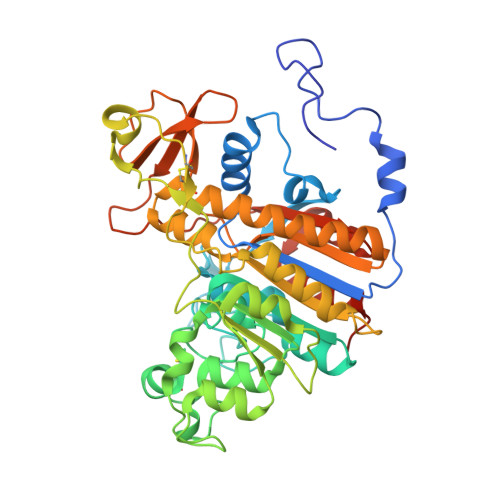Tungstate as a Transition State Analog for Catalysis by Alkaline Phosphatase.
Peck, A., Sunden, F., Andrews, L.D., Pande, V.S., Herschlag, D.(2016) J Mol Biol 428: 2758-2768
- PubMed: 27189921
- DOI: https://doi.org/10.1016/j.jmb.2016.05.007
- Primary Citation of Related Structures:
5C66 - PubMed Abstract:
The catalytic mechanisms underlying Escherichia coli alkaline phosphatase's (AP) remarkable rate enhancement have been probed extensively. Past work indicated that whereas the serine nucleophile (Ser102) electrostatically repels the product phosphate, another oxyanion, tungstate, binds more strongly in the presence of Ser102. These results predict a covalent bond between the serine nucleophile and tungstate, a model that we test herein. The crystal structure of tungstate-bound alkaline phosphatase provides evidence for a covalent adduct model and further shows that the ligand adopts trigonal bipyramidal geometry, which is infrequently observed for tungstate in small molecules and other active sites but mirrors the geometry of the presumed phosphoryl transfer transition state. The AP active site is known to stabilize another oxyanion, vanadate, in trigonal bipyramidal geometry, but the extent to which binding of either ligand reproduces the energetics of the transition state cannot be deduced from structural inspection alone. To test for transition state analog behavior, we determined the relationship between catalytic activity and affinity for tungstate and vanadate for a series of 20 AP variants. Affinity and activity were highly correlated for tungstate (r(2) = 0.89) but not vanadate (r(2) = 0.23), indicating that the tungstate•AP complex may better mimic this enzyme's transition state properties. The results herein suggest that tungstate will be a valuable tool for further dissecting AP catalysis and may prove helpful in mechanistic studies of other phosphoryl transfer enzymes.
Organizational Affiliation:
Department of Biochemistry, Stanford University, Beckman Center B400, Stanford, CA, 94305, USA.
















